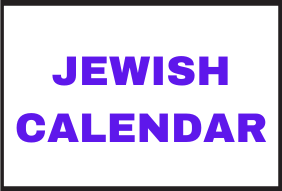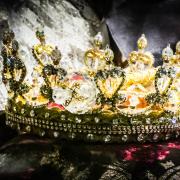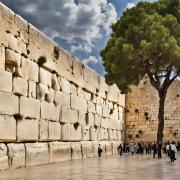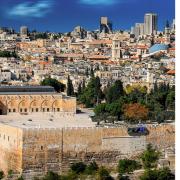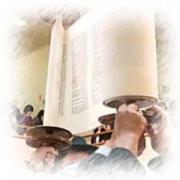Modesty or The Holy Scroll
Modesty or Tzeniut... When one hears either of these words, the first thing that usually comes to mind is: Oh come on! Do I really have to wear all that? It is so hot outside, I feel so layered up, like an onion... There are lots of excuses one can come up with, but allow me to show you the outcome of whichever choice you make.
I looked up the word "Modesty" in the dictionary, and this is what I found: Modesty is a mode of dress that intends to avoid encouraging sexual attraction in others. The word "modesty" comes from the Latin modestus, meaning "keeping within measure."
The word Tzeniut means: it describes both the character traits of modesty and discretion, and a group of Jewish laws pertaining to conduct. In modern times, the term has become more commonly used in reference to the rules of dress for women in Judaism.
The Sages say that if a woman keeps the laws of modesty as a reward, she will merit to marry a Cohen and have Cohanim Gedolim come from her. She will have children who may be Jewish judges, great sages, righteous people, and so much more—all of this just by being modest.
But what is it about modesty that so much can be gained from it?
In the book Power Points by Rabbi Ephraim Nissenbaum, there's a story in Parashat Nasso about a young woman who became observant and was bothered by the fact that Jews hold lavish Bar Mitzvahs for boys. At the same time, for girls, the Bat Mitzvah passes unnoticed.
So she asked her Rav, to which he replied, "The Vilna Gaon says that tzeniut or modesty is to a woman what Torah study is to a man, meaning it is her vehicle for spiritual growth. When a boy turns 13, he is counted as part of the minyan and called to the Torah. These are public events, and the celebration is, therefore, public as well.
When a girl reaches bat mitzvah, her defining moment is marked by an image of royalty through modesty. So with this spirit of modesty, her celebration is less public and more reserved."
An image of royalty is a great way to view it, but there could be more to it.
The Sages compare a woman to a Sefer Torah scroll. Since the Sefer Torah is holy and valuable, we dress it beautifully and hide it in a safe box or the Aron. Not only that, but if any of the letters in the scroll are missing or broken, the whole scroll becomes invalid or not kosher.
But what is the scroll made of? It is made of the skin of a kosher animal—klaf—and the sofer, the person who writes it, writes it in holiness and while meditating on the names of G-d.
The Midrash Tanchuma, Bereshit 1 says: How was the Torah written? It was written with letters of black fire on a surface of white fire or black ink against the white parchment.
I believe there could be more to the black fire on white fire.
We can literally compare them to a married couple—a woman as white fire and a man as black fire.
Just like in the Torah, if a letter is broken or falls from its original place, the scroll becomes invalid. So is the woman; if she is dressed immodestly, not according to Jewish law, she loses that energy or her white fire.
But what is this energy or the white fire?
In Bereshit 2:24 it says: "עַל־כֵּן֙ יַֽעֲזָב־אִ֔ישׁ אֶת־אָבִ֖יו וְאֶת־אִמּ֑וֹ וְדָבַ֣ק בְּאִשְׁתּ֔וֹ וְהָי֖וּ לְבָשָׂ֥ר אֶחָֽד׃ - Hence a man leaves his father and mother and clings to his wife, so that they become one flesh." What happens when the two of them become one flesh? Once the man and the woman are united in a holy act, when permitted by Jewish law, they combine their energies or their fires—black fire and white fire—and this is when the Presence of Hashem comes to dwell in their home, helping them grow in holiness.
When a woman dresses immodestly, she loses her energy, or white fire, and thereby her holiness. This causes the couple to get distracted from serving Hashem, and their goals switch from spiritual to physical, but this is not the only loss. This distraction weakens all the members of the family in their service to G-d and slowly moves them further and further away from Him. Since she has been with her husband, but he cannot cling to her, and they cannot become one flesh - thus they lose out in this world and the next. This is when the issues of Shalom Bayit and other problems arise.
When a woman keeps the laws of Modesty, she becomes a holy parchment—the white fire. A man becomes the black fire or the black ink. When they are together in the holy act, the couple becomes a Holy Letter of the Torah, with their children around them as crowns on that letter written on the holy parchment.
As families around the world strengthen in their modesty, they slowly grow in holiness. Hashem handpicks them to be part of his own Sefer Torah—The Living and Breathing Sefer Torah. These holy couples keep the laws of modesty and the laws of Torah, either from birth or by returning to their roots later in their lives, thus becoming part of the Holy Scroll of Hashem. And if the woman reveals little in an immodest way, that letter loses its place in the Holy Scroll of Hashem, but not only does the woman lose her place, the whole family is affected by it as well.
In the Megilat Ruth 2:5 says, "וַיֹּ֤אמֶר בֹּ֙עַז֙ לְנַעֲר֔וֹ הַנִּצָּ֖ב עַל־הַקּֽוֹצְרִ֑ים לְמִ֖י הַנַּעֲרָ֥ה הַזֹּֽאת׃ - Boaz said to the servant who was in charge of the reapers: Whose girl is that? Rashi explains, To whom does this maiden belong. What did Boaz see in Ruth? He saw her modest and wise behavior, how she picked up the wheat stalks, and did it modestly by sitting."
This act alone led to her marriage to Boaz, thus paving the way for a royal lineage to come from her—King David, King Shlomo, and the long-awaited Mashiach himself —because of her modesty.
But let's look at this from yet another angle.
It is written in the Torah, "The Israelites journeyed from Raamses to Succoth, about 600,000 men on foot, aside from children." (Shemot 12:37) They all traveled with their wives and children, and as it says in the Masechet Sotah 11B, "Rav Avira taught: In the merit of the righteous women that were in that generation, the Jewish people were redeemed from Egypt."
Also, the word "ישראל - Israel" can be read as an acronym for "Yesh Shishim Ribo Otiot LaTorah", meaning: "There are 600,000 letters in the Torah." Therefore, the nation of Israel did not leave Egypt until 600,000 holy couples were included in Hashem's Sefer Torah.
So, if problems come into this world, we have probably fallen short of our minimum of 600,000 families or letters in Hashem's Sefer Torah for modesty. If we improve on this collectively, it can be the answer to the problems the world faces today.
As we increase the number to 600,000+ families, we will increase our chances of bringing redemption closer and finally meeting Mashiach in the near future.
- - Part 2 - -
But let's go a bit deeper.
In Masechet Menachot 29B, we are told of this story:
"Rav Yehuda says that Rav says: When Moses ascended on High, he found the Holy One, Blessed be He, sitting and tying crowns on the letters of the Torah. Moses said before G-d: Master of the Universe, who prevents You from giving the Torah without these additions? G-d said to him: There is a man destined to be born after several generations, and Akiva ben Yosef is his name; he is destined to derive from each thorn of these crowns, mounds upon mounds of halakhot. For his sake, the crowns must be added to the letters of the Torah.
Moses said before G-d: Master of the Universe, show him to me. G-d said to him: Return behind you. Moses went and sat at the end of the eighth row in Rabbi Akiva's study hall and did not understand what they were saying. Moses' strength waned as he thought his Torah knowledge was deficient. When Rabbi Akiva arrived at the discussion of one matter, his students said, "My teacher, from where do you derive this? Rabbi Akiva told them: It is a halakha transmitted to Moses from Sinai. When Moses heard this, his mind was put at ease, as this was part of the Torah he would receive."
Those couples who are careful about the laws of modesty are like the holy couples that came before King David. Please take a look at this essay: King David's Lineage. These holy couples will merit being inscribed in Hashem's Sefer Torah. As it says in the above Gemara, Hashem ties the crowns to the letters as if Hashem rewards these couples with unbelievable Torah growth, and high-caliber children, who will grow to be prophets, great Talmidei Chachamim, and righteous and holy individuals. And this is how you raise an upright and holy family.
My Holy Nation -- Reserve and earn your place in Hashem's Living and Breathing Sefer Torah!!
Shmuel Katanov
8/17/2020



